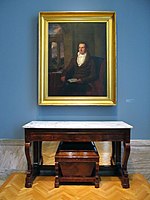History
Wood box containers as freestanding alcoholic beverage cabinets first appeared in Europe in the fifteenth century to hold and secure alcoholic beverages in public houses. Cellarettes first appeared in colonial America in the eighteenth century as a form of the European liquor cabinet. The main purpose of a liquor cabinet or cellarette was to secure wine and whiskey from theft as the bottles were hidden and the cabinet could have a lock.
During the American Revolutionary War and the Civil War army officers' cellarettes often came with crystal decanters, shot glasses, pitchers, funnels, and drinking goblets. Eighteenth century cellarette designs were used into the twentieth century. Cellarettes of the eighteenth, nineteenth, and twentieth centuries were found in taverns and pubs and, in some cases, in the private homes of the elite.
Prohibition in the United States brought about variations of trompe-l'œil cellarettes designed to conceal illegal alcoholic beverages. To the casual observer, the three dimensional trompe-l'œil artwork on these cellarettes made them appear to be an ordinary table, bookcase, or other piece of furniture.
Description
Cellarettes in England and America were custom designed wooden chests to carry, transport and store small numbers of bottled alcoholic beverages. They were often made of fine decorative wood like mahogany, rosewood, or walnut and could be of various shapes and sizes. Cellarettes were generally associated with dining room furniture. Sometimes cellarettes were small portable pieces of furniture with handles that could be moved from room to room in a house. Another type was a permanent piece of furniture built on a stand with a sliding shelf to hold glasses and a drawer for serving paraphernalia.
They could be free standing or built into a "pedestal-end" dining room buffet serving sideboard. Normally a cellarette had a hinged door or hinged top cover. Frequently a lock was provided, to secure the contents from thieves. Some cellarettes were lined internally with metal. This allowed wine or food to be iced keeping them longer than if they were at room temperature. The metal also prevented melted ice water from soaking into the wood. Men of wealth had as many as three cellarettes at a time as a status symbol, not necessarily indicating one was a heavy drinker.
In the late-18th and early-19th centuries, cellarettes were typically simple in design, following a Neoclassical aesthetic. Eventually, as Neoclassicism gave way to the more ostentatious Empire style, cellarettes became heavier and more ornate, emphasizing Roman and Grecian motifs. Some examples were made in the shape of sarcophagi mounted with lions' heads and animal-paw feet. Cellarette use declined in the 20th century due to the use of the refrigerator. [6]

The National Prohibition Act, known informally as the Volstead Act, was an act of the 66th United States Congress, designed to carry out the intent of the 18th Amendment, which established the prohibition of alcoholic drinks. The Anti-Saloon League's Wayne Wheeler conceived and drafted the bill, which was named after Andrew Volstead, chairman of the House Judiciary Committee, who managed the legislation.

Thomas Chippendale (1718–1779) was a cabinet-maker in London, designing furniture in the mid-Georgian, English Rococo, and Neoclassical styles. In 1754 he published a book of his designs in a trade catalogue titled The Gentleman and Cabinet Maker's Director—the most important collection of furniture designs published in England to that point which created a mass market for furniture—upon which success he became renowned. According to the Victoria and Albert Museum, "so influential were his designs, in Britain and throughout Europe and America, that 'Chippendale' became a shorthand description for any furniture similar to his Director designs".
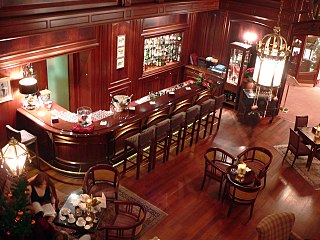
A bar, also known as a saloon, a tavern or tippling house, or sometimes as a pub or club, is a retail business establishment that serves alcoholic beverages, such as beer, wine, liquor, cocktails, and other beverages such as mineral water and soft drinks. Bars often also sell snack foods, such as crisps or peanuts, for consumption on their premises. Some types of bars, such as pubs, may also serve food from a restaurant menu. The term "bar" refers to the countertop where drinks are prepared and served, and by extension to the overall premises.
George Hepplewhite was a cabinetmaker. He is regarded as having been one of the "big three" English furniture makers of the 18th century, along with Thomas Sheraton and Thomas Chippendale. There are no pieces of furniture made by Hepplewhite or his firm known to exist but he gave his name to a distinctive style of light, elegant furniture that was fashionable between about 1775 and 1800 and reproductions of his designs continued through the following centuries. One characteristic that is seen in many of his designs is a shield-shaped chair back, where an expansive shield appeared in place of a narrower splat design.
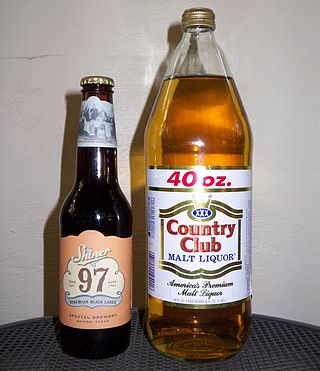
Malt liquor is a type of mass market beer with high alcohol content, most closely associated with North America. Legally, it often includes any alcoholic beverage with 5% or more alcohol by volume made with malted barley. In common usage, it refers to beers containing a high alcohol content, generally above 6%, which are made with ingredients and processes resembling those for American-style lagers.

A commode is any of many pieces of furniture. The Oxford English Dictionary has multiple meanings of "commode". The first relevant definition reads: "A piece of furniture with drawers and shelves; in the bedroom, a sort of elaborate chest of drawers ; in the drawing room, a large kind of chiffonier." The drawing room is itself a term for a formal reception room, and a chiffonier is, in this sense, a small sideboard dating from the early 19th century.

A sideboard, also called a buffet, is an item of furniture traditionally used in the dining room for serving food, for displaying serving dishes, and for storage. It usually consists of a set of cabinets, or cupboards, and one or more drawers, all topped by a wooden surface for conveniently holding food, serving dishes, or lighting devices. The words sideboard and buffet are somewhat interchangeable, but if the item has short legs, or a base that sits directly on the floor with no legs, it is more likely to be called a sideboard; if it has longer legs, it is more likely to be called a buffet.

Liquor is an alcoholic drink produced by distillation of grains, fruits, vegetables, or sugar, that have already gone through alcoholic fermentation. Other terms for liquor include: spirit, distilled beverage, spirituous liquor or hard liquor. The distillation process concentrates the liquid to increase its alcohol by volume. As liquors contain significantly more alcohol (ethanol) than other alcoholic drinks, they are considered 'harder'; in North America, the term hard liquor is sometimes used to distinguish distilled alcoholic drinks from non-distilled ones, whereas the term spirits is more common in the UK. Some examples of liquors include vodka, rum, gin, and tequila. Liquors are often aged in barrels, such as for the production of brandy and whiskey, or are infused with flavorings to form a flavored liquor such as absinthe.

A chest of drawers, also called a dresser or a bureau, is a type of cabinet that has multiple parallel, horizontal drawers generally stacked one above another.
BYOB or BYO is an initialism and acronym concerning alcohol that means "bring your own bottle" or "bring your own booze" or "bring your own beer".

A credenza is a dining room sideboard, particularly one where a central cupboard is flanked by glass display cabinets, and usually made of burnished and polished wood and decorated with marquetry. The top would often be made of marble, or another decorative liquid- and heat-resistant stone.

The State Dining Room is the larger of two dining rooms on the State Floor of the Executive Residence of the White House, the home of the president of the United States in Washington, D.C. It is used for receptions, luncheons, larger formal dinners, and state dinners for visiting heads of state on state visits. The room seats 140 and measures approximately 48 by 36 feet.

The Family Dining Room is a dining room located on the State Floor of the White House, the official residence of the president of the United States. The room is used for smaller, more private meals than those served in the State Dining Room. Used in the 1800s as a space for the First Family to have their meals, the Family Dining Room was used less for family meals and more for working lunches and small dinners in the 20th and 21st centuries.

Daniel Pabst was a German-born American cabinetmaker of the Victorian Era. He is credited with some of the most extraordinary custom interiors and hand-crafted furniture in the United States. Sometimes working in collaboration with architect Frank Furness (1839–1912), he made pieces in the Renaissance Revival, Neo-Grec, Modern Gothic, and Colonial Revival styles. Examples of his work are in the collections of the Metropolitan Museum of Art, the Philadelphia Museum of Art, the Art Institute of Chicago, and the Victoria and Albert Museum in London.

An alcoholic beverage is a drink that contains ethanol, a type of alcohol that acts as a drug and is produced by fermentation of grains, fruits, or other sources of sugar. The consumption of alcoholic drinks, often referred to as "drinking", plays an important social role in many cultures. Most countries have laws regulating the production, sale, and consumption of alcoholic beverages. Regulations may require the labeling of the percentage alcohol content and the use of a warning label. Some countries ban such activities entirely, but alcoholic drinks are legal in most parts of the world. The global alcoholic drink industry exceeded $1 trillion in 2018.
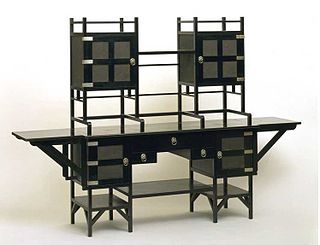
This sideboard was designed by Edward William Godwin (1833–86), who was one of the most important exponents of Victorian Japonisme or Anglo-Japanese style, the appropriation of Japanese artistic styles.

A Welsh dresser or a china hutch, sometimes known as a kitchen dresser or pewter cupboard, is a piece of wooden furniture consisting of drawers and cupboards in the lower part, with shelves and perhaps a sideboard on top. Traditionally, it is a utilitarian piece of furniture used to store and display crockery, silverware and pewter-ware, but is also used to display general ornaments.
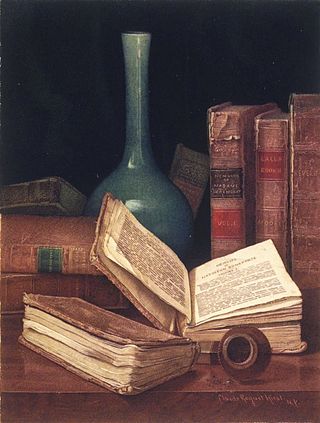
Claude Raguet Hirst was an American painter of still lifes. She was the only woman of her era to gain acclaim using the trompe-l'œil technique.
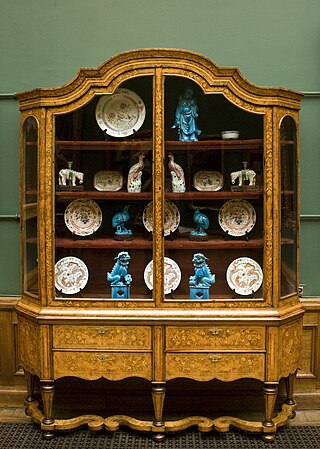
A china cabinet is a piece of furniture, usually with glass fronts and sides, used to hold and display porcelain ("china") or other ceramics. Typical china held in such cabinets often includes cups, plates, bowls, and glasses. Along with a table, chairs, and a sideboard, the china cabinet is one of the most typical elements of a traditional dining room in the Western world, though they may be placed in any room. Historically, they were used for especially highly decorated cabinet cups, that were too expensive and perhaps fragile for regular use, and made for collectors or to be given as presents.




